 |
|

|
 |
TABLE of CONTENTS
 |
Interstate 35W turns from freeway to runway |
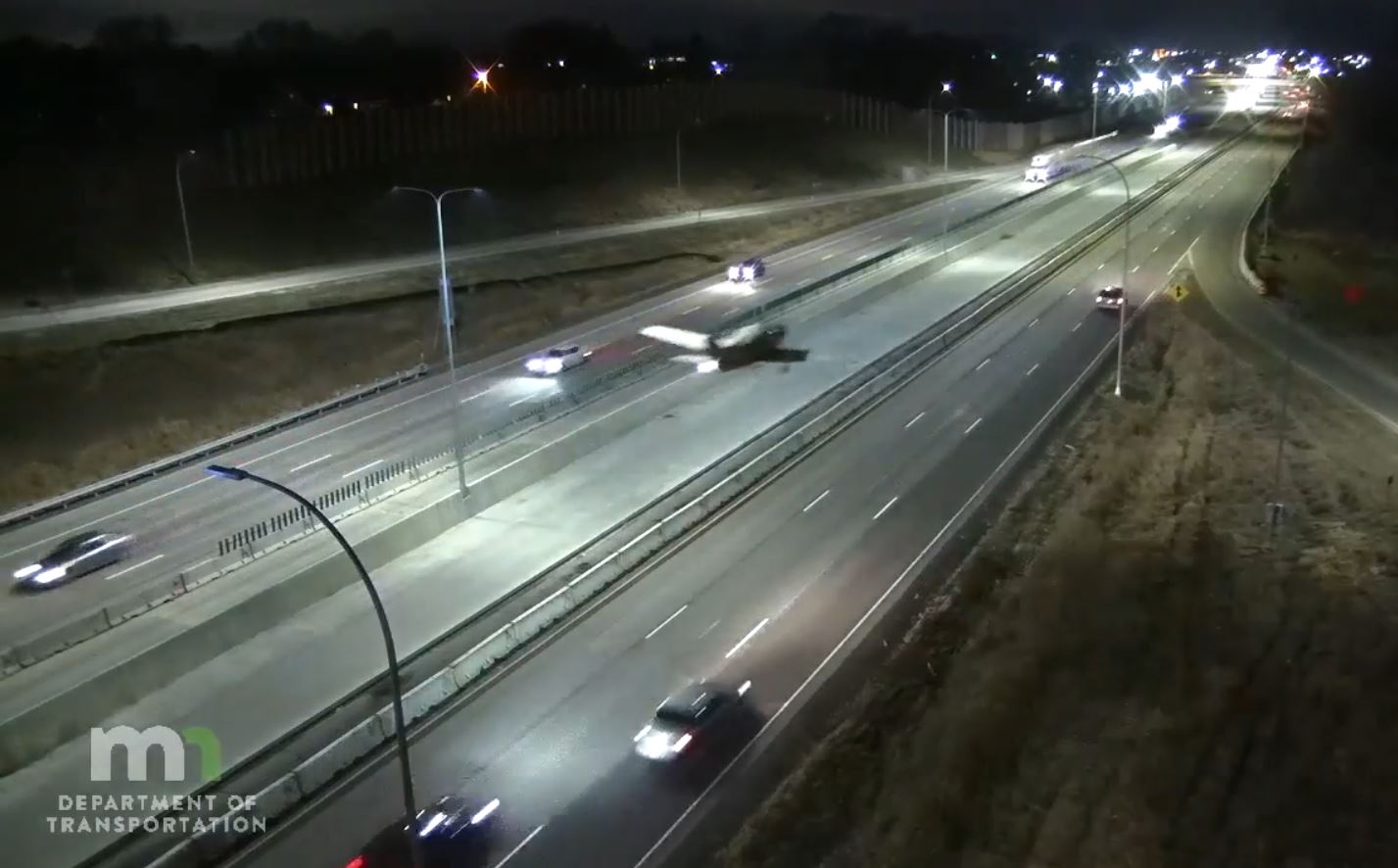
A still from the video seen 'round the world: this small plane made an emergency landing Dec. 2 on a stretch of Interstate 35 near Arden Hills. MnDOT traffic camera photo |
By Joseph Palmersheim
Merging on the freeway usually involves a left or right movement, not an up or down one.
Traffic came to a halt on a section of northbound Interstate 35W near Arden Hills Dec. 2 after the stretch of road turned into an emergency runway for a small plane. The single-engine Bellanca Viking landed in the northbound lanes near County Road E2 just before 9:30 p.m. It struck another vehicle on the interstate after landing, but no injuries were reported.
While it isn’t the first time an airplane has landed on a Minnesota freeway (a small plane ran out of fuel and crash-landed on I-35 in Chisago County in July 2016, and another made an emergency landing on I-35 near Stacy in February 2019), it’s the first landing that was caught by a MnDOT traffic camera, said Brian Kary, traffic operations director at the Regional Transportation Management Center in Roseville.
That video garnered media interest from across the planet, and a MnDOT Facebook post with the video Dec. 3 reached more than 1.2 million people.
“In case you missed it: A plane landed on 35W last night. (Yes, really!),” the post read. “While this isn't *quite* what we mean by a "multimodal transportation system," we're glad no one was injured and are impressed by the pilot's effort to zipper merge from above!”
So what happens when a plane lands in the road? In addition to the Minnesota State Patrol, the local fire department and ambulance were called to tend to any injured parties, much like a normal traffic incident. MnDOT’s role was to assist with traffic control and debris clean-up if needed. The airplane was removed on a flatbed and escorted out of the area by the state patrol. Traffic was detoured to County Road E.
“If it had happened during busier hours, the freeway would have been closed back at Hwy 36 where the other roadway can handle the heavier volumes,” Kary said. “For any freeway closure, the RTMC will utilize 511 and message signs to get the word out about the closure. Because it happened so late in the night, there wasn’t much impact to traffic.”
With more than 1,000 cameras running at the RTMC, no one was watching this particular camera right when the emergency landing happened, Kary said. It wasn’t until after the 911 calls came in that staff realized the camera was pointed in the right direction. They were able to play back the recording and saw that the emergency landing had been caught on camera.
“Considering something like this isn’t caught on camera very often, it is not surprising so many people were interested in seeing it,” Kary said. “We’re glad that there was a happy ending to the story, too.”
|
|

|
 |
TABLE of CONTENTS
 |
Winter driving updates program has phones buzzing in District 6 |
By Joseph Palmersheim
Ping!
What alert just showed up on your phone? If you are in District 6, it could be from MnDOT.
The district recently launched a pilot program to send winter driving alerts and updates via text message and email. Mike Dougherty, the district’s director of Public Engagement and Communications, said the initiative came about based on user feedback indicating an appetite for quick information.
The district was interested in reaching people quickly, too. As a subscriber to the GovDelivery service, MnDOT had the technology available to try. Dougherty said GovDelivery recently added text messaging capabilities, making it “a prime option” for emergency texting.
If research is any indication, this messaging has the chance to use a key connector: cellphones.
“Americans check their phones 96 times a day, or every 10 minutes, according to research,” Dougherty said. “It's personal, it gets people information and they can choose to get information right there.”
There’s a balance between reaching people and reaching people too much, though. Dougherty estimates that the district will send anywhere from five to 15 updates through the winter season (approximately six months), depending on the types of winter weather that hits and if there are significant crashes that might delay/stop traffic for two hours or more. The posts can be proactive (like preparing people for a blizzard) or reactive (letting people know about a jackknifed semi). The updates will focus on areas in the district with higher traffic volume, like as Interstate 35, I-90, Hwy 52, Hwy 14 and Hwy 61.
Regardless of the size of the road or the scope of the incident, the messages can only be so long.
“With text, the real art is brevity,” Dougherty said. “We have 160 characters to get this across. We're looking for, ‘What's the story?’ People want a quick message. It's a lot like our message signs. We’re thinking in bite-size pieces to get them information. And then if you have a way to provide a link for more information, people can help themselves.”
The help appears to be desired. Nearly 1,800 people have signed up to receive the updates, with 1,000 of those users registering within 48 hours of the initial communications rollout on Nov. 10.
“Most folks sound excited about it and think it makes total sense,” Dougherty said. “We intend to survey users at the end of the season to learn what they liked, what they didn’t and what suggestions they might have to improve it. We feel like that’s the culture of MnDOT - try something that might have wider applications to others, see how it works, what can we learn, and then present it for others to consider and discuss.”
The pilot is currently just for roads in the 11-county southeast Minnesota region. Based on the results of the user survey and considering staffing needs, MnDOT may explore wider statewide implementation of text alerts in the future.
|
 |
|

|
 |
TABLE of CONTENTS
 |
New pedestrian plan aims to improve walking options |
By Anne Meyer
Making places safer and more convenient for people to walk is critical to MnDOT’s mission. Now, thanks to the Office of Transit and Active Transportation, the agency has a new modal plan that lays out where and how to focus infrastructure investments - now and in the future.
The Statewide Pedestrian System Plan not only prioritizes locations for investment, it also provides new guidance to existing practices, offers opportunities to improve maintenance outcomes on the pedestrian system, and identifies potential costs to implement recommended improvements.
“We know walking is an essential part of any journey for many Minnesotans,” said Tori Nill, OTAT director. “We also know that MnDOT has a critical role in making investments and improvements that can reduce barriers to walking, whether it’s from home to school, from shop to shop, or from a parked vehicle to a community event.”
Not only will this plan help MnDOT’s work, it can also serve as a guide to communities across the state as they plan for future development.
“The MnDOT Statewide Pedestrian System Plan is providing an opportunity to better link accessibility obligations with a broader vision for the pedestrian network,” said Kristie Billiar, ADA Policy program manager. “The Ped Plan is providing the necessary tools to better identify pedestrian need and connect those needs with other accessibility improvements. These tools can be replicated at the local level, too.”
Contact Jake Rueter with any questions about the plan.
|
| |
|

|
 |
TABLE of CONTENTS
 |
Districts test new snowplow technologies to improve winter maintenance |
By Micaela Resh, Office of Research & Innovation
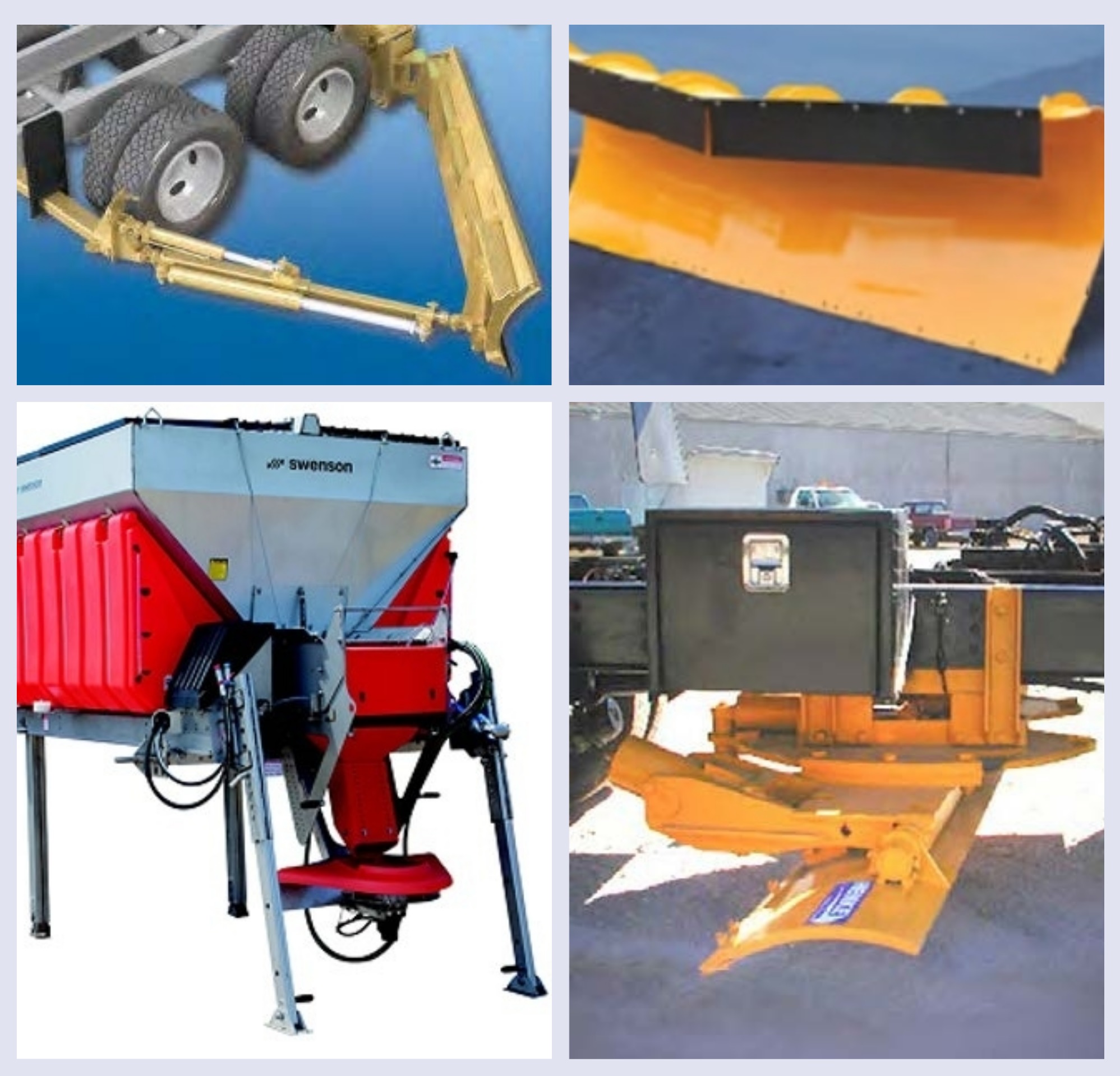
Clockwise, from top left: a True Float wing; a two-way reversible plow; an underbody scraper; and a Swenson slurry spreader. Submitted photos |
Every winter, MnDOT ensures Minnesotans can travel safely by plowing more than 30,000 lane miles with approximately 800 snowplows.
In a new research implementation project jointly funded by the Office of Research & Innovation and Office of Maintenance, MnDOT is testing five new pieces of snowplow equipment: two slurry spreaders (one from Henke, one from Swenson), a two-way reversible plow, an underbody scraper and a true-float wing (all from Henke).
The purpose of this project is to vet new technologies for feasibility of widespread deployment - taking cost, effectiveness, ease of use and safety into account.
“Our winter maintenance team strives to be proactive and innovative,” said Tom Peters, Maintenance Research & Training engineer, who is leading the project. “These new technologies can help us keep motorists safe and be more environmentally sustainable with our road salt use.”
Potential benefits
Both slurry spreaders will allow operators more control in directing salt, reducing salt use and reducing corrosion on the truck. The underbody scraper is intended to be a durable tool for removing packed snow and ice from the road. The two-way reversible plow and true-float wing will offer more mobility and reach while plowing.
If successful, these systems could help clear roads more quickly, providing a safe and reliable travel experience for Minnesotans. Reducing salt use could be another benefit by reducing environmental impact and operation costs.
Evaluation
Plow drivers will test this equipment on both rural and urban roads over three winter seasons. District 2 acquired and installed the two slurry spreaders last winter and will continue using them this season. The equipment will then be transferred to Metro District to test during winter 2021-22.
Researchers are gathering qualitative and quantitative field data. Last winter, they interviewed maintenance managers, operators and superintendents for insights on equipment installation, operation and service. This winter, they will capture equipment performance using two databases - Oracle Business Intelligence and WebMDSS - offering side-by-side comparisons with traditional slurry spreaders and material usage.
“Data-driven product evaluations like this equip MnDOT with the experience and perspectives needed to make smart investments,” said Brian Hirt, one of the lead researchers from CTC & Associates.
The project started in November 2019 and is estimated to be completed in January 2023.
To request project updates or learn more, visit MnDOT’s Office of Research & Innovation.
|
| |
|

|
 |
TABLE of CONTENTS
 |
Six states, 350 tons, one truck: OFCVO helps coordinate large cargo move |

This load, weighing almost 700,000 pounds (350 tons), needed to move more than 900 miles through six states. The cargo, a 280-foot-long deisobutanizer tower used in removing gases from crude oil, began its journey Nov. 6 in Oklahoma City, took nearly 16 days to reach Superior, Wis. Submitted photo |
By Kristi Schadegg, Office of Freight & Commercial Vehicle Operations
Transporting a truck load that weighs as much as two blue whales is no easy task.
Yet in July of this year, Barnhart Crane & Rigging called the Office of Freight & Commercial Vehicle Operations about doing just that. The load, weighing almost 700,000 pounds (350 tons), needed to move more than 900 miles through six states.
The cargo, a 280-foot-long deisobutanizer tower used in removing gases from crude oil, began its journey Nov. 6 in Oklahoma City. It then traveled at an average speed of 35 mph through Oklahoma, Kansas, Nebraska and South Dakota before reaching Minnesota after 12 days. It took an additional three-and-a-half-days to cross Minnesota before reaching its final destination: the Husky Refinery in Superior, Wis.
“Great partnership and coordination between MnDOT and WisDOT was observed as the planning for this load was shared with the joint MnDOT/WisDOT Blatnik bridge project team,” said Pat Huston, assistant District 1 engineer of major projects. “MnDOT is also currently leading the environmental study and documentation phase of a proposed 2028 major project on the Blatnik Bridge.”
The Blatnik Bridge, which connects Duluth to Superior, Wis., doesn’t allow oversize or overweight loads, so oversize/overweight load haulers must use the Bong Bridge. A load like this is often a long-term project requiring months, sometimes years, of planning, and involves many different government and public stakeholders. This move took nearly 16 days and involved 16 people.
Vehicle configurations of this proportion undergo a detailed review by the OFCVO Oversize/Overweight Permits unit and the Bridge Office to determine the potential route and feasibility for bridge capacity.
Check out this video to see highlights of the move.
|
| |
|

|
 |
TABLE of CONTENTS
 |
Tips and tricks for using Microsoft Teams |
Microsoft Teams has arrived at MnDOT, and Skype will be decommissioned by the end of January 2021.
The following topics are being produced in response to questions submitted to MNIT and the Technology Investment Management group.
Up-to-date information on Teams at MnDOT is available on the Teams MnDOT Website. Additional trainings offered by MNIT are offered here.
Testing your hardware with Teams
Worried that your mic won’t work for your next meeting? Want to make sure your colleagues can see your MnDOT photo during your next morning check-in? You can make a test call to ensure your mic, webcam, headset and speakers are all working like you like.
Simply launch Teams, click on “Settings” and Scroll down to “Devices.” Here you can change your default mic, speaker and camera settings and make a test call. Detailed instructions are available on the Manage your call setting in Microsoft Teams document available on the Teams MnDOT Website.
Creating Teams in… Teams
Creating Teams within Microsoft Teams is an easy way to collaborate with a group of people on a specific topic or project. Teams allow for group messaging and document collaboration. Find out more information on teams here.
To create a new team, you first need to register your Team. Teams registration information and forms are available on the Teams MnDOT Website. Team owners will need to take an additional training (ADMIN 00193 MnDOT Teams Owner).
Registering teams allows for an agency-wide directory to be compiled and shared. See the topics your colleagues are up to on the requests page within the Teams MnDOT Website.
Focus on the conversations that matter by managing notifications
With increased collaboration comes more updates and notifications. You can manage all notifications by clicking the “Activity” icon and then “Setting” (the gear icon). This will allow you to manage all notifications throughout the application.
Additionally, you are able to “hide” and “leave” teams where your work no longer overlaps. Hiding a team will place the team in a collapsed menu in the list of teams that you are a part of. You will still have access to team chat and documents. Leaving a team will remove you from accessing chat and documents shared in that team.
Need to get someone’s attention? Don’t forget to add an “@” followed by the employee’s name in chats. You are able to set different notification settings for @ mentions. This allows your colleagues to get your attention when they need it.
Remember, MnDOT teams channel chat, meeting chat and ad-hoc chat have a one-day deletion policy.
More information on notification management is available here.
This article was written by Evan Iacoboni, Matthew Baszner, Nkauj Her, Bobby Underhill and Susan Ogbemudia.
|
| |
|

|
 |
TABLE of CONTENTS
 |
Kim Collins is appointed deputy commissioner, chief administrative officer |

Kim Collins. Submitted photo |
Kim Collins will become MnDOT’s new Deputy Commissioner and Chief Administrative Officer, following the retirement of Scott Peterson Dec. 18.
Collins currently serves as the director of the Office of Civil Rights, and has been with MnDOT since 2004. She has held several roles with the agency, including time as an affirmative action investigator and later as a staff attorney in the Office of Chief Counsel. Prior to her MnDOT career, Kim worked in the private sector as an accountant and auditor.
She holds a bachelor’s degree in accounting from California State University Dominguez Hills and a juris doctorate from Hamline University School of Law. Collins was admitted to the Minnesota State Bar in 2009.
“Kim is an invaluable asset to MnDOT and I am grateful for her continued commitment and service,” said Commissioner Margaret Anderson Kelliher. “In her current role, I’ve been impressed with her ability to positively impact change, remove barriers and implement inclusive practices. She’s done an exceptional job advancing equitable approaches and overseeing our civil rights compliance programs, and her experience managing and working with a broad range of stakeholders and diverse audiences has uniquely prepared her for this new role.”
|
| |
|

|
 |
TABLE of CONTENTS
 |
Projects in Districts 2, 6 win work zone safety awards |
By Joseph Palmersheim
Two projects in District 2 and District 6 have won the 2020 Construction Work Zone Safety award.
Now in their 32nd year, the awards are sponsored by the Office of Construction and Innovative Contracting and are intended to recognize MnDOT construction projects for outstanding performance and innovation in the areas of work zone safety and traffic control.
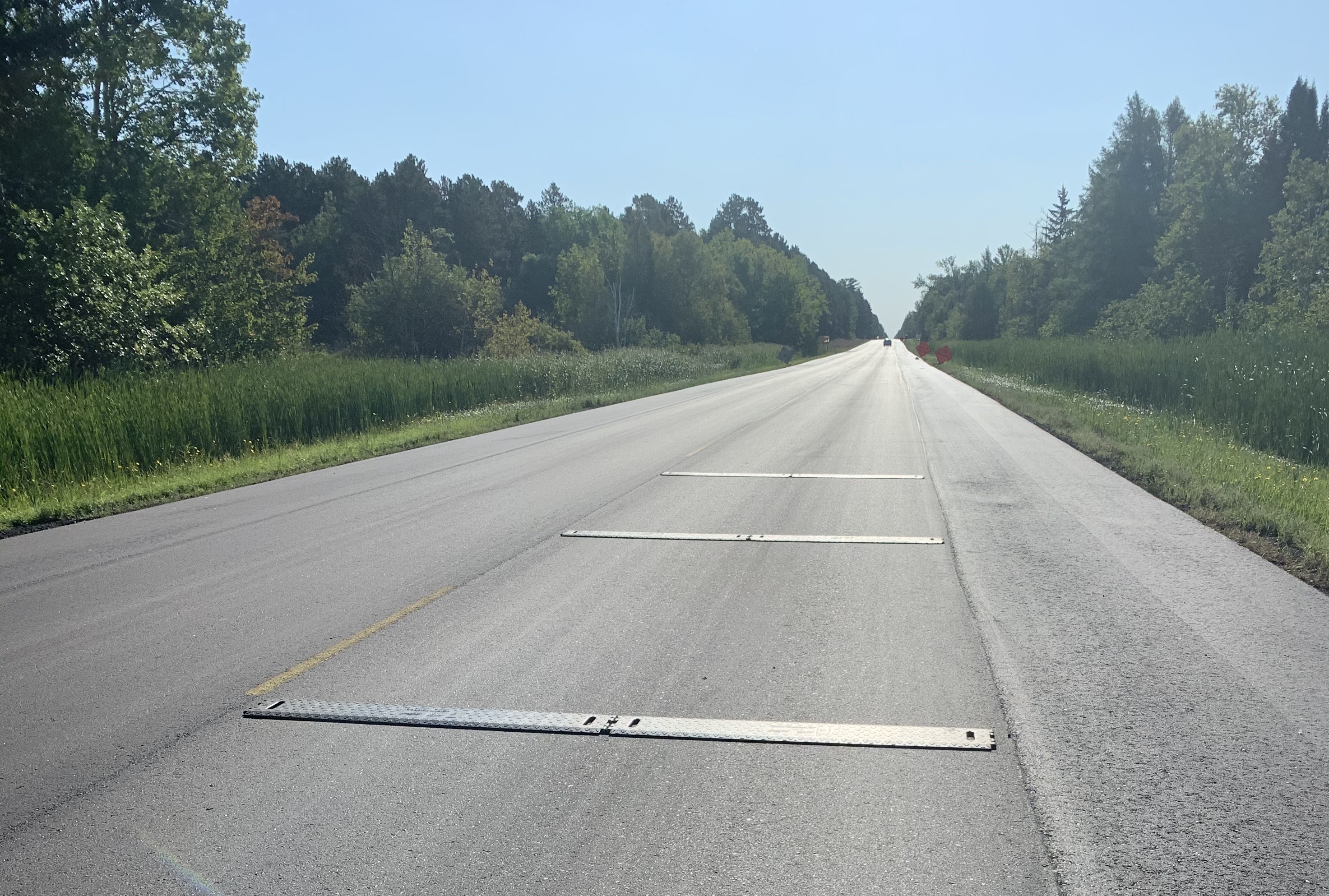
These rumble strips used on the Hwy 2 project in District 2 were meant to get the attention of drowsy and distracted drivers approaching the work area. The strips moved along with crews as the work progressed. Photo by Nancy Graham |
District 2 – Hwy 2 project in Cass and Itasca counties
Flaggers are often used to control traffic for road work on two-lane highways. Standing on the side of the road with a stop sign can be dangerous if distracted, high-speed traffic approaches, said Ted Ulven, Work Zone Safety supervisor. “This project used multiple sets of temporary rumble strips in advance of the project to get the attention of drowsy and distracted motorists.
“As the paving operation moved down the road, the contractor was diligent about relocating the rumble strips to keep up with the work crew,” Ulven said. “An additional innovation was the use of two pilot cars to minimize the delay to the public while keeping the workers safe. These practices contributed to a high degree of Work Zone Safety on this project.”
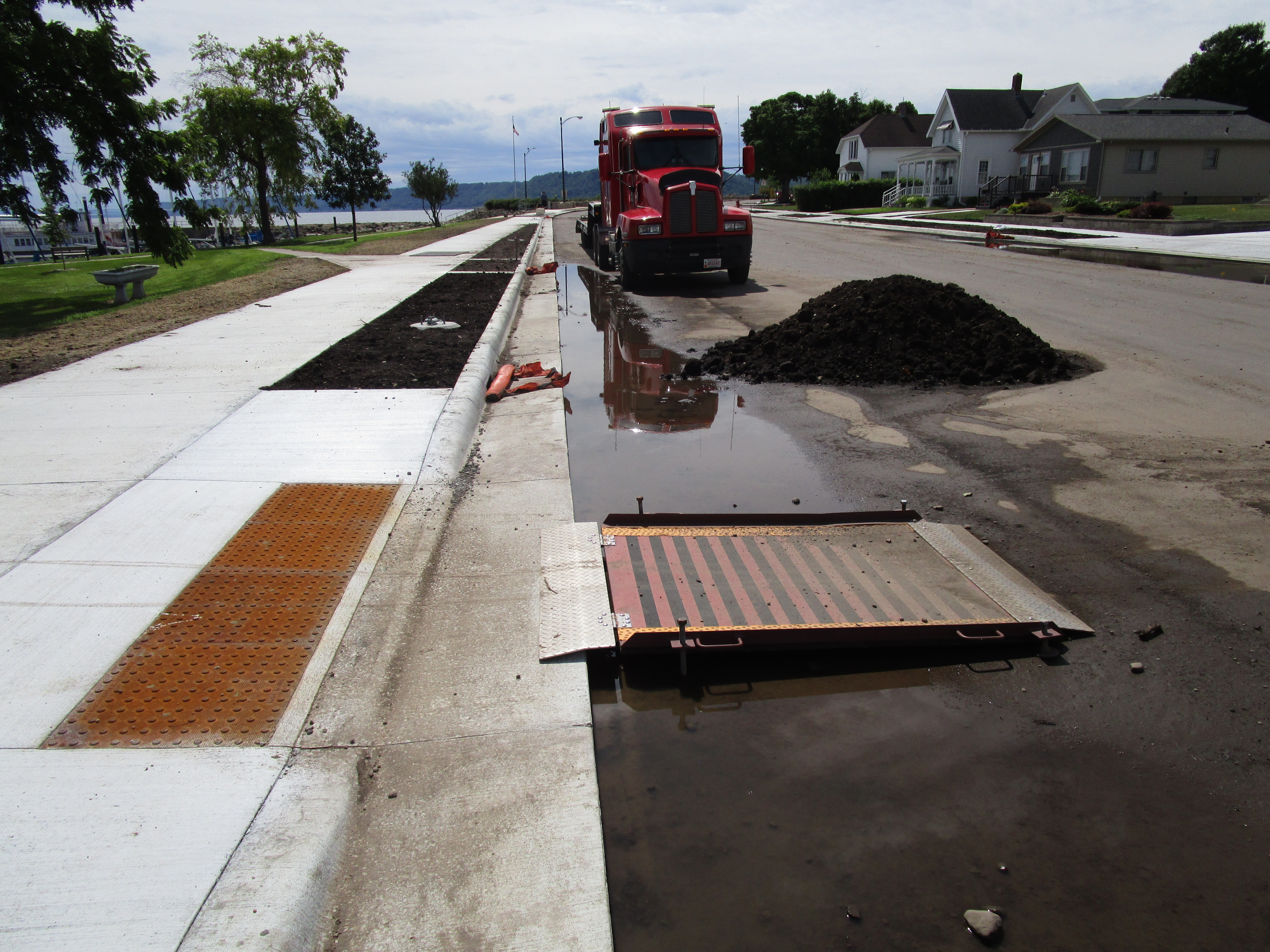
This curb ramp was one of several temporary, pedestrian-friendly installations to maintain ADA access on this summer’s Hwy 61 project in Lake City. Photo by Ted Ulven |
District 6— Hwy 61 project in Lake City
Hwy 61 was completely rebuilt in Lake City this summer. While the final product included many ADA upgrades and pedestrian-friendly elements, construction activities disrupted the normal flow of the downtown area.
“With plan details, contractor initiatives, and suggestions from residents and business owners, this project delivered a high degree of pedestrian access,” Ulven said. “Temporary ramps, walkway surfaces and signing were used extensively to maintain ADA access. The closure and detour for thru traffic was successful and used a temporary trailer-mounted traffic signal system at Hwy 63.”
The awards
Award recipients include MnDOT project staff, contractor’s employees, and Design-Build teams. Ulven, Troy Strassburg, construction standards engineer, and Jeff Morey, work zone standards specialist, reviewed the applications and made the award selections.
Criteria used to select the award winning projects were:
- Compliance to work zone traffic control standards and guidelines
- Improvements to existing traffic control plans, standards and guidelines
- Application of innovative work zone traffic controls
- Maintaining a good working relationship between project and contractor staff
- Communications/public relations
- Accident investigation/work zone improvement
The work zone safety awards are typically presented at the Minnesota Asphalt Conference. Due to the COVID-19 pandemic, it is uncertain if the February 2021 conference will be virtual or postponed.
“Congratulations to all of the award recipients,” said Tom Ravn, state construction engineer. “A special thank you is owed to everyone who made this past construction season successful.”
More information about the awards, including past winners, can be found here.
|
| |
|

|
 |
TABLE of CONTENTS
 |
Reminder: State Engagement and Inclusion Survey seeks employee feedback |
Minnesota Management and Budget is asking all state employees to share their views in an Engagement and Inclusion Survey. The deadline to complete the survey is Jan. 8, 2021.
The survey takes about 15 minutes. The survey is emailed to work email addresses from Management Analysis and Development (mnit@webhost.snapsurveys.com). The survey link is unique to each employee; do not forward these emails to anyone else.
Enterprise Talent Development, part of Minnesota Management and Budget, is leading the survey. Full results are expected by next year. Learn more about the survey here.
The survey is private. Each agency will receive survey results with all identifying information removed. After the survey results are compiled, MnDOT will receive the results and share them with employees. Each state agency will use the feedback to create action plans.
Employees who prefer a text-based version of the survey (for example, those using screen readers), select the “text only” link on the center of the top of the survey page. Contact MAD at 651-259-3800 or at management.analysis@state.mn.us for other accommodations.
|
| |
|

|
 |
TABLE of CONTENTS
 |
Make the world a better place |
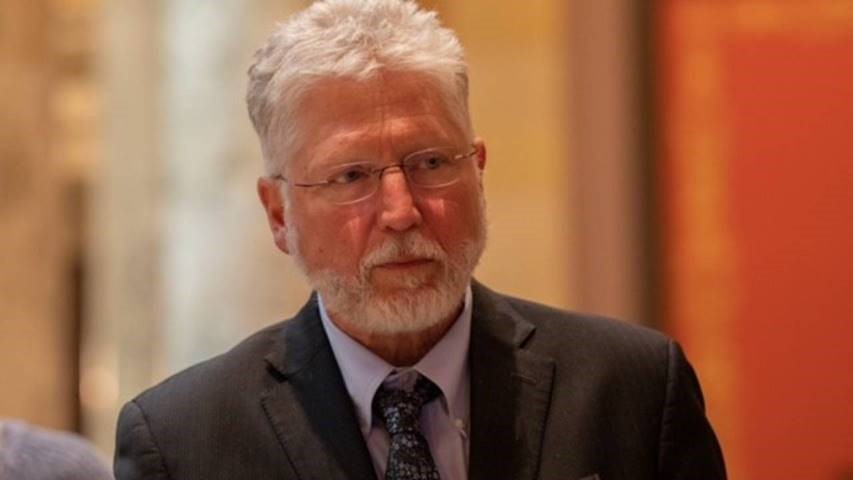
Scott Peterson. Photo by John Kaul |
By Scott Peterson, deputy commissioner and chief administrative officer
Friends and colleagues,
It’s hard for me to fully comprehend that this day has finally arrived. Retirement is something I’ve thought about occasionally, but it always seemed like it was in the distant future. But time is relentless.
It has been my privilege to work with so many kind, talented people on issues that matter to Minnesotans. I am grateful to call many of you my friends, and I will miss seeing and talking to you on a regular basis.
As a younger man trying to carve out a career for myself, I didn’t envision the path I would ultimately take. In fact, I didn’t spend much time thinking about where my career might go at all, but I tried to keep doing the right thing and doing it as well as I could. In the end, I found myself right where I wanted to be: learning, doing interesting work, advancing policy to improve transportation and provide the funding to make it all possible. It was by working with elected leaders, stakeholders and MnDOT leaders we established many changes you can see throughout Minnesota.
I continue to be sincerely humbled when I think of the people who helped me, believed in me, and gave me these opportunities. Working in the Commissioner’s Office for five commissioners and governors from three political parties is an achievement in itself! I will always be especially grateful to Commissioner Anderson Kelliher for giving me the opportunity to conclude my career as your Deputy Commissioner. But as much as I have enjoyed this opportunity, I’m ready to move on to the next phase of my life.
Now as an experienced, older person heading toward the door, perhaps some of what I have learned can help you.
First, since we all spend so much time at work, make being at work as enjoyable as possible. If you can be anything, be kind.
Next, it’s important to respect and recognize the contributions of the people around you—no one does it by themselves.
Remember that honesty in your interactions with others is essential, and your relationships and the trust you build are the most valuable currency you have.
Don’t carry grudges and don’t burn bridges.
If you find something that stirs your soul, devote yourself to it and you will be rewarded with success and satisfaction.
Finally, leadership means taking risks, because if you are leading you are making a path to an unknown destination.
Society, and the transportation sector in particular, must find a way to rapidly transform to address the critical issues of social justice and climate change. I have confidence that you can rise to the challenge, but it will take new ideas, rethinking priorities, and questioning the status quo and standard practices. You have new, talented leaders who are capable of taking on these challenges, but everyone must help them out.
Be well, stay healthy and care for those around you.
Make the world a better place. That’s all I ask.
Editor’s note: Peterson retires Friday, Dec. 18, after 29 years of state service. In a message earlier to employees, Commissioner Margaret Anderson Kelliher noted:
“Scott has been a leader in providing sound policy and fiscal management to MnDOT, most notably through his prominent role in the development of our financial policies. He also helped lead the agency through a number of significant events, including an economic downturn, the catastrophic Interstate 35W Bridge collapse and, most recently, the unprecedented impacts of the COVID-19 pandemic.
“In his role developing the Tribal Affairs Program, sponsoring and supporting MnDOT Employee Resource Groups and serving as a member of the Executive Inclusion Council, Scott has been a faithful advocate for bringing all voices to the table including those that have been historically underrepresented.
“Scott is also an ardent advocate for addressing climate change, from his role in creating a Chief Sustainability Officer and sharing the most up-to-date climate research with his colleagues, to championing and personally demonstrating that we all can play a part in supporting our broader sustainability efforts across the enterprise.
“Scott has served with the utmost integrity throughout his career at MnDOT. He has been a trustworthy advocate for transportation policy grounded in doing the right thing. He is a trusted mentor to many, and his leadership and presence will be sorely missed. MnDOT and Minnesota are better for having had Scott as our champion, and I wish him all the best in his hard-earned and well-deserved retirement.”
|
| |
|
| |
|



